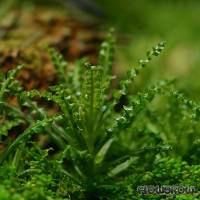



Also called "daonoi" or "downoi" (Thai for "litte star"), Pogostemon helferi has been known to science for over 120 years, however, it was only discovered for aquaristic purposes in 1996, by Nonn Panitvong and Arthit Prasartkul, who found it in the Thai province Kanchanaburi, on the border to Myanmar. Within only a short period, P. helferi has become a very popular aquarium plant for the fore- and middleground.
These authors found the species on a fast-flowing river with limestone ground. The plants grow on and between rocks, submersed for most of the rainy season in summer, and often in a strong current. During autumn and winter, the populations of P. helferi fall dry and form upright shoots with striking flower spikes typical for the genus Pogostemon.
This Pogostemon species is easy in cultivation, given that specific requirements are met: sufficient light (0.5-1+ watt per litre), an ample CO2 supply and adequate levels of fertiliser including nitrate, phosphate, potassium and magnesium. The plant needs quite a lot of iron, to which it responds with a lush green leaf colour.
Insufficient light induces etiolation, i.e. the internodes get longer, and the leaf colour changes into a yellowish hue.
Propagation is quite easy, given that you use a cutting tool with sharp edges. Cut shortly under a node. You can shorten the lower leaves a bit so the cutting has a better hold in the substrate. This works with top as well as with lateral cuttings. Planting is best done with a pair of plant tweezers to avoid bruising.
This plant species is best suited for accentuating the middleground in a nano or small aquarium. Place in the foreground in larger tanks. Be careful when handling it, it bruises easily, which may lead to dieback. Attaching Pogostemon helferi to wood or rocks is also a possibility and is best done with a nylon thread. Make sure you avoid bruises, do not draw the thread too tight. Pogostemon helferi is also a very nice plant for paludariums and can be cultivated partially emersed, partially submersed there.
<a href="https://www.flowgrow.de/db/aquaticplants/pogostemon-helferi" target="_blank"><img alt="Pogostemon helferi" title="Pogostemon helferi" src="https://www.flowgrow.de/db/widget/aquaticplants/pogostemon-helferi" /></a>
[url=https://www.flowgrow.de/db/aquaticplants/pogostemon-helferi][img]https://www.flowgrow.de/db/widget/aquaticplants/pogostemon-helferi[/img][/url]
[widget=aquaticplants/pogostemon-helferi]Pogostemon helferi[/widget]